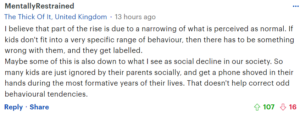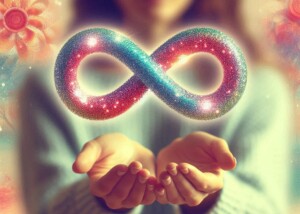Are you inclined to believe that “mild” presentations of autism are really just variations of normal human behavior, even in kids?
Is high functioning autism or “low support needs” autism, in fact, just a way of thinking and acting that falls within a normal bell curve of the human brain?
Check out the screenshot below of an MSN article in which Dr. Allen Frances, a psychiatrist, expresses that an autism diagnosis is too often given to children who merely have a “variation of the normal” in terms of their behaviors.

Ironically, Dr. Frances led an update to the guidelines in the DSM-IV (1994) that loosened the definition of autism to include people with milder symptoms.
Since when is feeling different your entire life, since early childhood, a variation of normal?
It is NOT normal to persistently (that’s the key word: persistently) feel different or disconnected from the human species.
Some skeptics may blame this on a person choosing to be disengaged from others.
Well, this theory bombs because people with an autism diagnosis (Level 1, or “low support needs” or “high functioning”) will tell you, hands down, that from an early age, often since preschool, they have felt different from other human beings — on a persistent nature, regardless of setting.
And nobody in their right mind would consider my intense aversion to stickers (e.g., on fruit, water bottles, thermoses and nearly every product under the sun that you can buy off a shelf) as a “variation of normal.”
Aside from feeling alien all one’s life and sometimes having very heightened or bizarre sensory issues, there’s also so much more to Autism Spectrum Disorder.
So many people remain skeptical about whether or not somebody is actually autistic.
The commenter below somewhat implies that giving kids excessive screen time can cause behaviors that resemble autism. Now that’s just nuts.

The ignorance of some of the skeptics about the existence of a low-support-needs form of ASD is nothing short of astounding, as shown in the comment below.

The comment above was posted to an article describing, in moderate detail, 10 traits of autism.
Clinically diagnosed with ASD, I strongly hit nine of the traits. The remaining one sort of applied to me, but it wasn’t a strong resonation.
There is NO WAY that the average neurotypical would think they have autism upon “reading it,” as Commenter sssss5964 insists.
Perhaps most of the traits resonated with that commenter, and maybe that reader is autistic but thinks they’re neurotyical.
I didn’t begin realizing I was autistic until I was in middle age.
So it’s quite possible that many skeptics, who believe that checklists can apply to anyone, are autistic themselves but have no idea! Thus, it’s easy to see why they’d believe that a description of signs would apply to nearly anybody.
Ask any late-diagnosed Autistic if — prior to realizing that autism was the only condition that connected all the dots for their lifelong experiences — they used to think that “everyone did” a certain behavior of theirs, that they eventually realized was due to their autism.
Every Autist will raise a hand. I myself can think of several things I’ve done all my life that I thought “everyone did,” but now realize are due to my autism.
One of those things is that of relentlessly — and I mean relentlessly — rehearsing anticipated conversations, and scripting word-for-word or almost word-for-word, briefer comments I planned on making to people, or answers to their anticipated questions.
This is not a variation of normal when it’s done on a daily basis, including when I’m on a treadmill or even driving on a highway.
A neurotypical would not find most autism traits resonating with them, let alone an entire list.
An example is my NT sister, who took the Autism Quotient Test.
A score of 26 (out of 50) is the threshold. She scored a 4. Her NT husband scored a 15. I scored a 31.
Autism Is NOT a Variation of Normal Behavior or Thinking
I wonder if the naysayers — who insist that what is often called high functioning or low support needs autism — know that the very first person ever diagnosed with autism actually led a fairly independent life and was a banker!
Donald Triplett, from Mississippi, was identified as “Case 1” in Dr. Leo Kanner’s landmark 1943 paper titled “Autistic Disturbances of Affective Contact,” which described 11 kids with a distinct pattern of behavior that Dr. Kanner labeled as “early infantile autism.”
Are the skeptics going to label pioneering autistic advocate Temple Grandin as a variation of normal because she “made it to adulthood” before getting a clinical autism diagnosis and became a book author and reknowned animal scientist who has been living independently all her adult life?
- Must autism always be Rain Man?
“If it were just a ‘variation of normal,’ I wouldn’t have spent my entire life feeling broken for not being able to do what everyone else made look easy,” says Cassie Roybal, a late-diagnosed AuDHD licensed professional counselor and founder of EmpowHERed Divergence Therapy.
“The pain wasn’t from being different. It was from being expected to perform normal at all costs.
“Also, the levels of autism and even what people use to define support needs tend to come from what external support you need or what external challenge you pose to other people.
“Oftentimes, high-masking individuals (those who often have lower external support needs) have learned to compensate internally or overfunction, meaning that outwardly, their autism doesn’t externally cause many challenges for others or require high support from others.
“But the internal cost is often very high. The amount of external support needs someone has does not correlate with their internal suffering level.
“And neurotypical people do not have high levels of internal suffering related to the core features of autism.”
Autism has often been described, by the autistic community, as a variation of the human experience.
This is not the same as “variation of normal.” The full MSN/Daily Mail article is here.


 Cassie Roybal is a late-diagnosed AuDHD therapist (LPC) and founder of
Cassie Roybal is a late-diagnosed AuDHD therapist (LPC) and founder of 







































